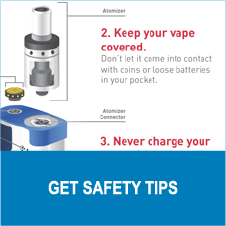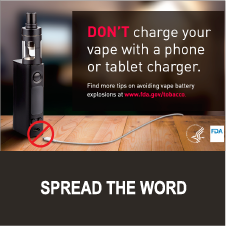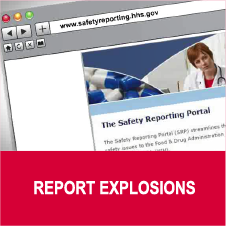Tips to Help Avoid "Vape" Battery Explosions
You may have heard that e-cigarettes, or "vapes," can explode and seriously injure people. Although they appear rare, these explosions are dangerous. The exact causes of such incidents are not yet clear, but some evidence suggests that battery-related issues may lead to vape explosions. The safety tips below may help you avoid a vape battery explosion. Please report a vape explosion or any other undesired health or quality problems with a vape to the FDA.
What Else Can I Do?
Until all vapes and vape batteries conform to strong and consistent safety standards, your best protection against vape battery explosions may be knowing as much as possible about your device and how to properly handle and charge its batteries.
- Make sure you read and understand the manufacturer's recommendations for use and care of your device. If your vape did not come with instructions or you have further questions, contact the manufacturer.
- Don't remove or disable safety features—like fire button locks or vent holes—that are designed to prevent battery overheating and explosions.
- Only use batteries recommended for your device. Don't mix different brands of batteries, use batteries with different charge levels, or use old and new batteries together.
- Charge your vape on a clean, flat surface, away from anything that can easily catch fire and someplace you can clearly see it—not a couch or pillow where it is more prone to overheat or get turned on accidentally.
- Protect your vape from extreme temperatures by not leaving it in direct sunlight or in your car on a freezing cold night.
- Learn how to pack your device and batteries safely for air travel:
Downloads
Share these safety tips with your friends—download the images below and share with your social media community.
How Do I Report a Vape Battery Explosion to FDA?
FDA is aware of explosion events and is collecting data to help address this problem. Please report a vape explosion, or any undesired health or quality problems with a vape, to the FDA through the Safety Reporting Portal. When you fill out the form, please be sure to include:
- The name of the vape manufacturer
- The brand name, model, and serial number of the vape
- The brand name and model of the battery
- Where it was purchased
- Whether the product was used differently than intended by the manufacturer
- Whether the product was modified in any way
Learn more about how to report a battery explosion to the FDA in the video below.
- Lopez CF, Jeevarajan JA, Mukherjee PP. Characterization of lithium-ion battery thermal abuse behavior using experimental and computational analysis. J Electrochem Soc. 2015;162(10):A2163–A2173.
- 3.7 Safety. In Gates Energy Products. Rechargeable Batteries Applications Handbook. Boston: Butterworth-Heinemann, 1998:149-51.
- Carriage of Spare Lithium Batteries in Carry-on and Checked Baggage. Washington, DC: US Department of Transportation, Federal Aviation Administration; 2015. SAFO 15010.
- Lotfi N, Fajri P, Novosad S, Savage J, Landers R, Ferdowsi M. Development of an experimental Testbed for research in lithium-ion battery management systems. Energies. 2013;6(10):5231–5258.
- US Consumer Product Safety Commission. Consumer Product Safety Alert: Household Batteries Can Cause Chemical Burns. http://www.nchh.org/Portals/0/Contents/CPSC_Battery_Burns.pdf. Accessed November 4, 2016.
- Zhao W, Luo G, Wang C. Modeling internal shorting process in large-format Li-Ion cells. J Electrochem Soc. 2015;162(7):A1352–A1364. 7. Finegan DP, Scheel M, Robinson JB, et al. Investigating lithium-ion battery materials during overcharge-induced thermal runaway: An operando and multi-scale x-ray CT study. Phys Chem Chem Phys. 2016;18(45):30912–30919.
- US Fire Administration. Electronic Cigarette Fires and Explosions. https://www.usfa.fema.gov/downloads/pdf/publications/electronic_cigarettes.pdf. Published October 2014. Accessed November 4, 2016.
- US Federal Aviation Administration. Batteries Carried by Airline Passengers: Frequently Asked Questions. https://www.faa.gov/about/office_org/headquarters_offices/ash/ash_programs/hazmat/passenger_info/media/
Airline_passengers_and_batteries.pdf. Published September 9, 2016. Accessed November 4, 2016. - Blum AF, Long RT. Fire Hazard Assessment of Lithium Ion Battery Energy Storage Systems. Springer New York; 2016.
- Lyon RE, Walters RN, Crowley S, Quintiere JG. Fire Hazards of Lithium Ion Batteries presented at: International Aircraft Systems Fire Protection Working Group Meeting; October 21-22, 2015; Atlantic City, New Jersey. https://www.fire.tc.faa.gov/pdf/systems/Oct15Meeting/Lyon-1015-LIBs.pdf. Accessed November 4, 2016.
- US Federal Aviation Administration. Vapes on a Plane Marketing Kit. https://www.faa.gov/hazmat/packsafe/resources/vapes_marketing_kit/. Accessed August 26, 2020.
Additional Resources
- Safety Reporting Portal for Tobacco Products
- Vaporizers, E-Cigarettes, and other Electronic Nicotine Delivery Systems (ENDS)
- FDA's Deeming Regulations for E-Cigarettes, Cigars, and All Other Tobacco Products
- Learn about Different Types of Tobacco Products
- Federal Aviation Administration: Vapes On a Plane Marketing Kit














